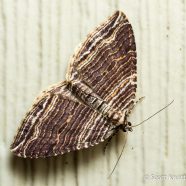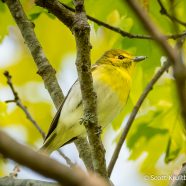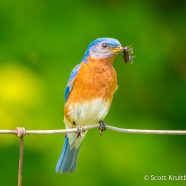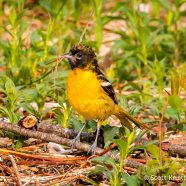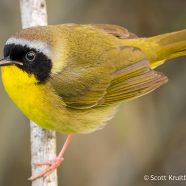Many-lined Carpet Moth
Here is the Many-lined Carpet Moth (Anticlea multiferata) on a recent evening…can’t imagine why they call it that, huh…
Read MoreYellow-throated Vireo
The Yellow-throated Vireo (Vireo flavifrons) seen here did plenty of singing and foraging for me on a recent spring morning while his mate tended to their new nest. They were located, as always, on the edge of a large forest, and while they love the cuts they do need sizable, unbroken woodlands. If you take a look at them from afar you may wonder why they have such a plumage…but if you look at some of my photos you may not have to ponder that anymore. What a perfect camouflage, especially in the spring! I have no doubt those looks help the species coax their insect prey into easy...
Read MoreEastern Bluebird Feeding
May is the time for the next generation of Eastern Bluebirds (Sialia sialis) to join our world as nest boxes across the land are filled with the growing and begging beaks of nestlings. These young birds, like so many others, require a lot of constant room service, and mom and dad are busy feeding them nonstop. I took only a moment to photograph this Bluebird as I did not want to interrupt it as it headed home with a delivery. Their unbelievably beautiful plumage looks unreal against the increasingly green backgrounds of forest adjacent to this orchard. The line between art and life is very...
Read MoreBaltimore Oriole Nest Building
This first-spring male Baltimore Oriole (Icterus galbula) was a busy fella, methodically sorting through all sorts of nest building material as I watched him last week. He would gather some grass, straw and other vegetation, carefully crafting it and arranging it just right, then flying back off to his mate and his tree. You may have seen a Baltimore Oriole nest, hanging from several points of a tree branch, without evening knowing what it was. The female bird constructs a sack or sock-like container that is carefully woven together with such craftsmanship that they often stay attached to...
Read MoreCommon Yellowthroat
This male Common Yellowthroat (Geothlypis trichas) and I are rather close…or at least we were for about 30 seconds on a recent May morning. This bird is a migrant, though you may end up with a resident in a yard near you. Their common name does betray their abundance, and gardens, marshes, fields, forests or anywhere they can skulk about in dense, low vegetation works for them. Being a habitat generalist has helped the species end up as one of our most common warblers. It also makes them a frequent target of Brown-headed Cowbirds and brood parasitism, like the abundant Yellow Warbler....
Read More



